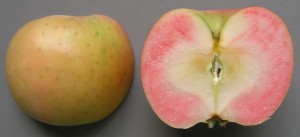
Photo shows Rose Pearl, a new mid-season apple variety suitable for both fresh consumption and processing. (Courtesy of Institute of Fruit Tree Science)
National Agriculture and Food Research Organization’s Institute of Fruit Tree Science in Tsukuba, Ibaraki Prefecture, announced on Tuesday, January 21 that it has developed a new mid-season pink-fleshed apple variety Rose Pearl.
The yellow-skinned apple has a moderately acidic flavor and crispy texture. It is suitable both for eating fresh and processing, and the institute says the new variety can be used in various innovative recipes by making use of its pink flesh color, hopefully leading to an increase in apple consumption.
Most apple varieties on the market have white or yellowish-white flesh, and there are little varieties with red flesh. Red-fleshed apples are recently attracting attention for use in cooking and processing, but the existing varieties have coarse flesh with strong acidic flavor, so processing firms were hoping for better quality.
The institute, which has been aiming at developing all-purpose, red-fleshed apples, selected Rose Pearl in 1990 by crossing Fuji with Pink Pearl, a red-fleshed variety developed in the United States.
Harvesting period for Rose Pearl is mid- to late October in Morioka, Iwate Prefecture, where the variety is grown, roughly the same season as a mid-season variety Kogyoku. Its skin is yellow, and turns slightly pinkish on the sunny side. Its size is large, weighing roughly 390g.
Its flesh color is about the same as Pink Pearl, or a little more reddish. It is juicy and crisp in texture. Its sugar content is 14 to 15 degrees Brix, and its acid content is about 0.6 percent. It does not taste as sour as Kogyoku or Pink Pearl, but has a moderately acidic flavor and is more suitable for processing compared with Ruby Sweet, another new red-fleshed variety which the institute announced last December.
Since Rose Pearl rarely rusts, it can be grown for fresh eating without bagging. Disorders such as spots do not occur often, so it is easy to grow. The institute estimates the yields for the variety will be about the same as major varieties such as Tsugaru. Young trees will be put on sale in autumn.
(Jan. 22, 2014)

